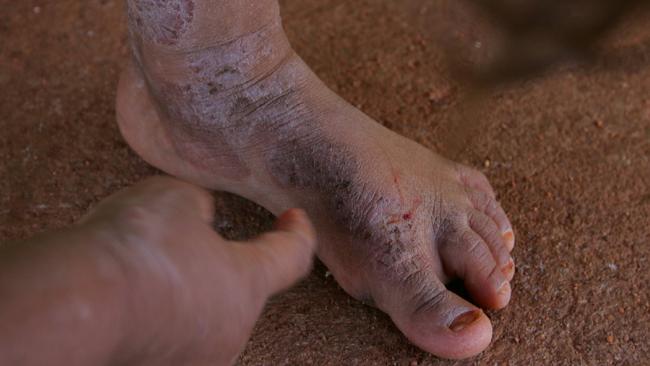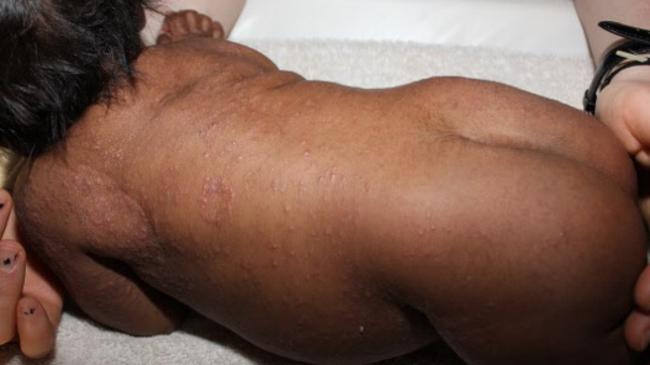Palmerston mother horrified after her children became infected with scabies
A PALMERSTON mum is horrified after two of her children became infected with scabies.

Northern Territory
Don't miss out on the headlines from Northern Territory. Followed categories will be added to My News.
A PALMERSTON mum is horrified two of her children have been infected with scabies and says parents need more education about the infectious skin disease.
The mother, who asked for her identity to be withheld, said she first took her daughter, who attends Gray Primary School, to the pharmacy two weeks ago after she developed hivelike spots on her skin.
“I thought it was hives so took her to the chemist and spoke to the pharmacist who told me it was hives and gave me antihistamines,” she said.
“When my son also developed the spots I knew it was unlikely they both had hives so took them to the doctor.”
During the consultation with the GP on Monday evening the woman said her husband was told he had seen three other children that day also infected with scabies.
To treat the disease the whole family was told to take medication immediately and again in one week and the house thoroughly cleaned to stop the disease being spread.
“The doctor said they probably came into contact with it at school,” she said.
“They’ve had school sores, ringworm and nits – they’re constantly sick with things they’re picking up at school because children aren’t sent home, I’m over it.”
The mum of three said more education about scabies should be made available.
The NT Department of Education said it had not received any reports of scabies affecting students at Gray Primary School.
“The Department of Education takes the health and safety of all students and staff seriously and acts accordingly to ensure appropriate care is provided,” a spokeswoman said. “If a school is made aware of an infectious disease a letter will be sent home explaining students may have come in contact with an infected person.
“The infected person is excluded from school as per NTG Centre for Disease Control requirements.”
Centre for Disease Control director Dr Vicki Krause said scabies was not a notifiable condition.

THE SPREAD OF SCABIES
BEFORE they’ve even celebrated their first birthday seventy per cent of indigenous children in remote communities will have been infected by scabies at least once.
It’s one of the many preventable diseases plaguing our remote communities and contributing to the premature death of indigenous Territorians.
But it’s a scourge philanthropist and entrepreneur Dr Sam Prince, through his organisation One Disease, is determined to fight — announcing a $1.2 million investment into helping eradicate the disease in Northern Territory remote indigenous communities.
One Disease aims to eliminate preventable disease, one at a time from remote indigenous communities — first on the list being scabies.
Human scabies is a parasitic infestation caused by a mite, barely visible to the naked eye that burrows into the skin and lays eggs triggering a host immune response that leads to intense itching
Scabies infestation is frequently complicated by bacterial infection, leading to the development of skin sores that, in turn, can cause more serious consequences such as septicaemia, heart disease and chronic kidney disease.
The new funding will support two skin-health nurses to identify and manage the severe form of scabies (crusted scabies) in East and West Arnhem Land.
The medical doctor and founder of Mexican restaurant chain Zambero said a $600, 000 donation by pharmaceutical company MSD teamed with an additional $600,000 from an unnamed benefactor would bring One Disease a step closer to its goal of empowering indigenous Australians to self-manage scabies, reduce the disease burden and ultimately eliminate the severe form of the disease by 2030.
Fiona Hildebrand is one of the nurses working for One Disease in indigenous communities to assist in training local clinics and educating both clinics and households with recurrent scabies problems on the best way to stop the disease.
“We don’t go into communities unless we’re welcome but the response has been really good and the communities are really supportive of what we’re trying to do,” she said.
“We can sit down with them in a non-clinical setting and have a more comprehensive discussion about barriers they may have in accessing treatment and work out solutions to overcoming those barriers … it really works.”


